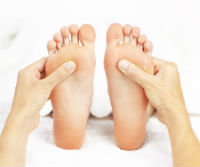Reflexology for Thyroid Health
/Reflexology is a gentle, complementary and alternative medical (CAM) therapy in which pressure is placed along reflex points on the feet, lower leg, hands, face, or ears. A Reflex Map identifies various reflex points and corresponding regions or systems throughout the body. A certified reflexologist uses specific patterns of touch and pressure to stimulate these points.
The theory that underlies reflexology is that stimulation of the reflex points opens the flow of energy (referred to as Life Force or Chi) and nutrients throughout the body. It is believed that reflexology taps into the body's natural healing process by enhancing the functioning of the lymphatic system (a major part of the immune system), which helps move fluids and waste products from within the tissues into the circulatory system, ultimately for excretion from the body.
Generally, reflexology is suitable for everyone, from newborn babies to those receiving end of life care. A reflexologist tailors each session to the individual, taking into account both physical and emotional factors that might be affecting you. Reflexologists aim to work alongside both allopathic and holistic healthcare practitioners to promote well-being for their clients.
CAM researchers have investigated reflexology for a variety of health conditions, such as breast cancer, diabetes, anxiety, back pain, menstrual issues, post-operative recovery, chronic fatigue, and thyroid dysfunction. The premise for treating thyroid conditions with reflexology is that opening the energy flow through the thyroid gland can balance both hyperthyroid and hypothyroid conditions by supporting the gland in regulating homeostasis, the body's ideal state of equilibrium. In some studies of thyroid goiter or cancer, reflexology reduced pain and promoted relaxation, which can boost healing.
While there have been promising results in many case studies (of just one person or a small group), there is still a need for further research to definitively indicate the effectiveness of reflexology for treating illness.
Resources
- Reflexology Association of America. "Reflexology USA"
- Reflexology Research. "Reflexology for Thyroid." Accessed May 2015.
- Reflexology Research Project Presents."Reflexology Research"
Image Attribution: elenathewise/bigstockphoto.com



